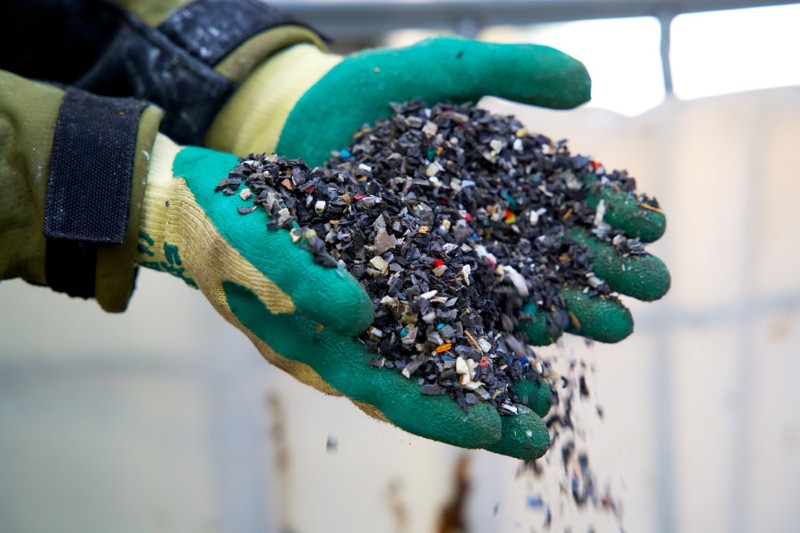To construct a circular economy for plastics, expanding chemical recycling will be essential.
Japan has been one of the world’s largest generators of plastic packaging waste per capita. Among efforts to reduce reliance on fossil fuels, chemical manufacturers are seeking ways to create a circular economy for plastics, in which new plastic products are produced from plastic waste rather than petroleum. Using mechanical and chemical recycling, which recovers carbon from plastic waste and reuses it in new products, Sumitomo Chemical, based in Tokyo, Japan, is poised to expand its capacity to make plastic recycling more efficient and economical.
Recycling challenge
Japan only recycles about 24% of its plastic waste; 62% is burned, and used to generate electricity, emitting carbon dioxide to the atmosphere. Of the 24% of plastic waste that is recycled, 88% is done mechanically, where it is shredded into fine flakes or melted down and then reshaped into other products. One example is the production of outdoor garments (fleeces) from plastic bottles. The other 12% of recycled plastic waste is processed using chemical recycling.
Mechanical recycling is best for products made from a single type of plastic. However, the increasing production of goods from multiple types of plastics means that fewer products are suitable for materials recycling. “Most products on the market are a mix of different types of plastics,” explains Shuichi Kimata, a deputy general manager of the Research Planning and Coordination Department at Sumitomo Chemical. “Much effort has gone into designing mixed plastics with functionality in mind, which is convenient for consumers, but not ideal for waste management.”
For instance, packaging for popular meals such as ready-made curries consists of an inner layer of aluminium with several outer layers of various plastics. When mixed plastics like these undergo materials recycling, they yield raw materials that don’t retain the original properties. Impurities introduced by multiple rounds of recycling rapidly degrade properties, such as colour.
In April 2022, Japan enacted a law promoting the circulation of plastics, which is designed to encourage manufacturers to design plastics that are easier to recycle. This has spurred the development of monomaterials, which are made from a single type of plastic, but act like mixed ones, Kimata says. “However, while monomaterials could make more plastics suitable for recycling, there are immense technical hurdles in making them. And even if monomaterials do emerge on the market, it would be extremely difficult to match the functionality of mixed plastics,” he says. “Chemical recycling will increasingly be a crucial technology moving forward.”
Breaking plastics down
Unlike mechanical methods, chemical recycling methods break long chains of molecules in plastics down into their building blocks, or monomers. The process generates raw materials such as ethylene and propylene from mixed plastics, which are then used for new plastic products.
Sumitomo Chemical is investing in a technique that thermally degrades high-quality mixed plastics to obtain gases like ethylene and propylene. The project is being conducted in collaboration with Muroran Institute of Technology in Hokkaido, Japan, and Maruzen Petrochemical, based in Tokyo. “The catalysts employed in this process help generate a significantly higher yield of olefin gases, which contain two to five carbon atoms per molecule,” explains Yasuhiko Mori, a group manager of the Essential Chemical Research Laboratory at Sumitomo Chemicals. “This is efficient as it foregoes intermediates like carbon monoxide or carbon dioxide, which require energy to convert back to plastic.”
To process plastic waste contaminated by non-plastic elements, like food scraps and grime, the company has partnered with Sekisui Chemical, based in Tokyo, to convert waste into ethanol using microorganisms, and ultimately to polyethylene, a common plastic. In April 2022, the company established a test facility for the process in their Chiba factory. More collaborations are underway with Kyoto University, Shimane University and The National Institute of Advanced Industrial Science and Technology to produce alcohols directly from carbon monoxide, carbon dioxide and hydrogen. “We aspire to produce methanol, ethanol and propanol, which give higher yields of valuable olefin gases,” explains Mori.
Circular economy
While the company strives to make chemical recycling processes scalable at an industrial level, consumers must also find value in recycled plastics in order to establish a circular economy. “Since chemical recycling is a more laborious process than producing new plastics from petroleum, chemically recycled products will inevitably be more expensive,” explains Kimata. “Cutting production costs is unlikely to make recycled plastics as cheap as new ones.”
To enhance the perceived value of recycled plastics, Sumitomo Chemical has launched Meguri® (which means circulation in Japanese), a brand of plastic products that have been manufactured from mechanically or chemically recycled plastics. “It’s a brand to unite businesses and consumers in circulating plastic,” says Mori. “The products will look the same as virgin plastic on the outside, but if the raw material came from recycled plastic, we designate it a Meguri product.”
In July 2022, Sumitomo Chemical announced a partnership with Sekisui Chemical and cosmetics giant, Shiseido, to build a resource circulation model for products. Cosmetics packaging on the market today is designed with mixed plastics, as it needs to offer protection for the content inside, ease of use, as well as pleasing visual aesthetics. “The goal is to create a market for sustainable plastics, so that there will be added value in buying a recycled plastic product,” says Kimata.
For chemical manufacturers, circulating carbon from waste to new products is the best way forward for carbon neutralization, says Kimata. “For the chemical industry, pursuing decarbonization in areas like the energy sector, which are moving away from carbon-emitting sources, is not an option. We need carbon for our raw materials,” he says. “For that, we need to see carbon in waste as a source of raw materials, recover it, and circulate it back into the production chain.”
Through partnerships with industry, academia and consumers, Sumitomo Chemical is striving to establish a circular economy for plastics.

